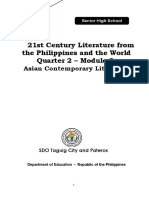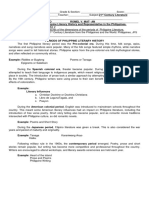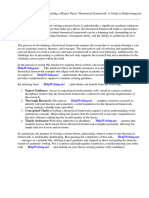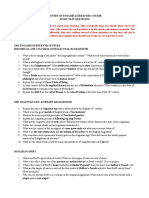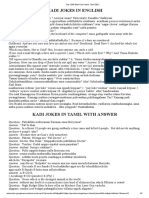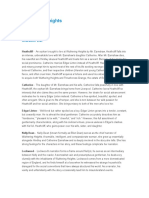0 ratings0% found this document useful (0 votes)
535 viewsTagalog: para Abbing (Ibanag)
Tagalog: para Abbing (Ibanag)
Uploaded by
Tricia FaithThe tanaga is the Filipino equivalent of the Japanese haiku. A tanaga is a four line poem with each line having between 7-9 syllables, compared to the haiku's 3 phrases of 5, 7, and 5 phonetic units. Most tanagas are written in Tagalog and do not have titles, referring instead to their apparent theme. Philippine folk literature also includes proverbs, extended tanagas, folk songs, narratives, and epics that vary among ethnic groups and explore themes of life, work, celebrations, and history. The oral traditions help validate cultural beliefs and were historically taught by elders but were less known to Filipinos due to colonial influences emphasizing Philippine history starting in 1521.
Copyright:
© All Rights Reserved
Available Formats
Download as DOCX, PDF, TXT or read online from Scribd
Tagalog: para Abbing (Ibanag)
Tagalog: para Abbing (Ibanag)
Uploaded by
Tricia Faith0 ratings0% found this document useful (0 votes)
535 views3 pagesThe tanaga is the Filipino equivalent of the Japanese haiku. A tanaga is a four line poem with each line having between 7-9 syllables, compared to the haiku's 3 phrases of 5, 7, and 5 phonetic units. Most tanagas are written in Tagalog and do not have titles, referring instead to their apparent theme. Philippine folk literature also includes proverbs, extended tanagas, folk songs, narratives, and epics that vary among ethnic groups and explore themes of life, work, celebrations, and history. The oral traditions help validate cultural beliefs and were historically taught by elders but were less known to Filipinos due to colonial influences emphasizing Philippine history starting in 1521.
Original Title
TANAGA 1.docx
Copyright
© © All Rights Reserved
Available Formats
DOCX, PDF, TXT or read online from Scribd
Share this document
Did you find this document useful?
Is this content inappropriate?
The tanaga is the Filipino equivalent of the Japanese haiku. A tanaga is a four line poem with each line having between 7-9 syllables, compared to the haiku's 3 phrases of 5, 7, and 5 phonetic units. Most tanagas are written in Tagalog and do not have titles, referring instead to their apparent theme. Philippine folk literature also includes proverbs, extended tanagas, folk songs, narratives, and epics that vary among ethnic groups and explore themes of life, work, celebrations, and history. The oral traditions help validate cultural beliefs and were historically taught by elders but were less known to Filipinos due to colonial influences emphasizing Philippine history starting in 1521.
Copyright:
© All Rights Reserved
Available Formats
Download as DOCX, PDF, TXT or read online from Scribd
Download as docx, pdf, or txt
0 ratings0% found this document useful (0 votes)
535 views3 pagesTagalog: para Abbing (Ibanag)
Tagalog: para Abbing (Ibanag)
Uploaded by
Tricia FaithThe tanaga is the Filipino equivalent of the Japanese haiku. A tanaga is a four line poem with each line having between 7-9 syllables, compared to the haiku's 3 phrases of 5, 7, and 5 phonetic units. Most tanagas are written in Tagalog and do not have titles, referring instead to their apparent theme. Philippine folk literature also includes proverbs, extended tanagas, folk songs, narratives, and epics that vary among ethnic groups and explore themes of life, work, celebrations, and history. The oral traditions help validate cultural beliefs and were historically taught by elders but were less known to Filipinos due to colonial influences emphasizing Philippine history starting in 1521.
Copyright:
© All Rights Reserved
Available Formats
Download as DOCX, PDF, TXT or read online from Scribd
Download as docx, pdf, or txt
You are on page 1of 3
The Filipino equivalent of a Japanese haiku is tanaga.
In Philippine literature, a tanaga is a poem consisting of four lines with
each line equally having between seven and nine syllables. To
compare, the Japanese haiku has 17 phonetic units divided into three
phrases of 5, 7 and 5 units respectively.
These short poems do not have any titles, although the apparent
theme is used to refer to it. Most are written in Tagalog, the basis of
the Filipino national language.
The proverbs or aphorisms express norms or codes of behavior,
community beliefs or they instill values by offering nuggets of wisdom
in short, rhyming verse.
The extended form, tanaga, a mono-riming heptasyllabic quatrain
expressing insights and lessons on life is “more emotionally charged
than the terse proverb and thus has affinities with the folk lyric.” Some
examples are thebasahanon or extended didactic sayings from
Bukidnon and the daraida and daragilon from Panay.
The folk song, a form of folk lyric which expresses the hopes and
aspirations, the people’s lifestyles as well as their loves. These are
often repetitive and sonorous, didactic and naive as in the children’s
songs or Ida-ida(Maguindanao), tulang pambata (Tagalog) or cansiones
para abbing (Ibanag).
A few examples are the lullabyes or Ili-ili (Ilongo); love songs like
the panawagon and balitao (Ilongo);harana or serenade (Cebuano);
the bayok (Maranao); the seven-syllable per line poem, ambahan of the
Mangyans that are about human relationships, social entertainment
and also serve as a tool for teaching the young; work songs that
depict the livelihood of the people often sung to go with the movement
of workers such as the kalusan (Ivatan),soliranin (Tagalog rowing song)
or the mambayu, a Kalinga rice-pounding song; the verbal
jousts/games like theduplo popular during wakes.
Other folk songs are the drinking songs sung during carousals like
the tagay (Cebuano and Waray); dirges and lamentations extolling the
deeds of the dead like the kanogon (Cebuano) or the Annako (Bontoc).
A type of narrative song or kissa among the Tausug of Mindanao,
the parang sabil, uses for its subject matter the exploits of historical
and legendary heroes. It tells of a Muslim hero who seeks death at the
hands of non-Muslims.
The folk narratives, i.e. epics and folk tales are varied, exotic and
magical. They explain how the world was created, how certain animals
possess certain characteristics, why some places have waterfalls,
volcanoes, mountains, flora or fauna and, in the case of legends, an
explanation of the origins of things. Fables are about animals and
these teach moral lessons.
Our country’s epics are considered ethno-epics because unlike,
say, Germany’s Niebelunginlied, our epics are not national for they are
“histories” of varied groups that consider themselves “nations.”
The epics come in various
names: Guman (Subanon); Darangen (Maranao); Hudhud (Ifugao);
andUlahingan(Manobo). These epics revolve around supernatural
events or heroic deeds and they embody or validate the beliefs and
customs and ideals of a community. These are sung or chanted to the
accompaniment of indigenous musical instruments and dancing
performed during harvests, weddings or funerals by chanters. The
chanters who were taught by their ancestors are considered
“treasures” and/or repositories of wisdom in their communities.
Examples of these epics are the Lam-
ang (Ilocano); Hinilawod (Sulod); Kudaman (Palawan);Darangen(Maran
ao); Ulahingan (Livunganen-Arumanen Manobo); Mangovayt Buhong na
Langit (The Maiden of the Buhong Sky from Tuwaang–Manobo); Ag
Tobig neg Keboklagan (Subanon); and Tudbulol (T’boli).
Reflection:
The diversity and richness of Philippine literature evolved side by side
with the country’s history. This can best be appreciated in the context
of the country’s pre-colonial cultural traditions and the socio-political
histories of its colonial and contemporary traditions.
The average Filipino’s unfamiliarity with his indigenous literature
was largely due to what has been impressed upon him: that his
country was “discovered” and, hence, Philippine “history” started only
in 1521.
So successful were the efforts of colonialists to blot out the
memory of the country’s largely oral past that present-day Filipino
writers, artists and journalists are trying to correct this inequity by
recognizing the country’s wealth of ethnic traditions and disseminating
them in schools and in the mass media.
The rousings of nationalistic pride in the 1960s and 1970s also
helped bring about this change of attitude among a new breed of
Filipinos concerned about the “Filipino identity.
You might also like
- English Translation of Al Quran Ul Kareem - Kanzul Iman (Free Download)Document1,306 pagesEnglish Translation of Al Quran Ul Kareem - Kanzul Iman (Free Download)Ayshah100% (1)
- Song 1: Oh, The Thinks You Can Think!Document4 pagesSong 1: Oh, The Thinks You Can Think!api-237757052No ratings yet
- Storytelling and Other Poems (Field Enterprises, Inc)Document208 pagesStorytelling and Other Poems (Field Enterprises, Inc)Lucy Sam Williams100% (3)
- Ba Da Shen ZhouDocument4 pagesBa Da Shen ZhouJimmy Alexander100% (2)
- The Literary Forms in Philippine LiteratureDocument29 pagesThe Literary Forms in Philippine LiteratureJohannin Cazar ArevaloNo ratings yet
- 21 Century Literature From The Philippines and The WorldDocument23 pages21 Century Literature From The Philippines and The WorldDevon2 CastilloNo ratings yet
- RWS - 11 - Lesson 9Document34 pagesRWS - 11 - Lesson 9Ron GruellaNo ratings yet
- Edith Tiempo Recovered 1Document12 pagesEdith Tiempo Recovered 1Denmark AleluyaNo ratings yet
- Module 11Document2 pagesModule 11Elaine Varde100% (1)
- 21st Century Literature 1st Mid QuarterDocument84 pages21st Century Literature 1st Mid QuarterMERIDIAN SEES100% (13)
- Contemporary ArtsDocument2 pagesContemporary ArtsSideTrip SideKick100% (1)
- 21st Centruy Q1-PTDocument3 pages21st Centruy Q1-PTDIWANIE R. PEREZNo ratings yet
- 21st Century Literature From The Philippines and The World: Quarter 1-Week 1Document11 pages21st Century Literature From The Philippines and The World: Quarter 1-Week 1MJ Toring Montenegro75% (4)
- Historical Background: Chapter 2: The Pre-Spanish PeriodDocument2 pagesHistorical Background: Chapter 2: The Pre-Spanish PeriodRaquel LimboNo ratings yet
- SENIOR HIGH SCHOOL-Practical Research 1: A. Most Essential Learning Competency (MELC)Document7 pagesSENIOR HIGH SCHOOL-Practical Research 1: A. Most Essential Learning Competency (MELC)JOHN REALDANo ratings yet
- Tanaga: The Tanaga Is An Indigenous, Traditionally in TheDocument1 pageTanaga: The Tanaga Is An Indigenous, Traditionally in TheJOSHUA CAWALING MANZONNo ratings yet
- 21st Century Literature Week 1 PDFDocument25 pages21st Century Literature Week 1 PDFCecilia ReyesNo ratings yet
- Periods of Philippine LiteratureDocument7 pagesPeriods of Philippine LiteratureAngelica Ciubal100% (1)
- American EraDocument24 pagesAmerican EraRonnie GavionNo ratings yet
- H. Ilokano LiteratureDocument2 pagesH. Ilokano LiteratureKimberly Ann AsuncionNo ratings yet
- Module 3 Fiction RDocument4 pagesModule 3 Fiction Rapi-348267175100% (4)
- Reading - and - Writing - Skills - Q1 - Session1 - Narration, Description, DefinitionDocument74 pagesReading - and - Writing - Skills - Q1 - Session1 - Narration, Description, DefinitionZenmar Luminarias GendiveNo ratings yet
- Tangible ArtsDocument53 pagesTangible ArtsAira Eunice EscasaNo ratings yet
- Emtech Module3 Ans KeyDocument2 pagesEmtech Module3 Ans KeyEugene Amos Espiritu100% (1)
- Gawad NG Manlilikha NG BayanDocument35 pagesGawad NG Manlilikha NG Bayanyanyan 14No ratings yet
- Various Contemporary Art Forms andDocument62 pagesVarious Contemporary Art Forms andRoselyn L. Dela CruzNo ratings yet
- LIPS 12 Week 6Document10 pagesLIPS 12 Week 6JonielNo ratings yet
- Contextual Reading ApproachesDocument73 pagesContextual Reading ApproachesMnM Vlog OfficialNo ratings yet
- 21stCL Q1 M9Document13 pages21stCL Q1 M9Anna Marie Agravante100% (1)
- English As The Medium of Instruction For Science and Its Effects On The Languages of The PhilippinesDocument22 pagesEnglish As The Medium of Instruction For Science and Its Effects On The Languages of The PhilippinesMatt ChenNo ratings yet
- Act ThesisDocument2 pagesAct ThesisMatet Generosa50% (2)
- Hyper Poetry Text Tula Blog andDocument17 pagesHyper Poetry Text Tula Blog andSir RilvenNo ratings yet
- 21st Literature Lesson 1Document5 pages21st Literature Lesson 1jv calambuhayNo ratings yet
- Module 2 The Major Literary GenresDocument2 pagesModule 2 The Major Literary GenresRuth Kristel SantosNo ratings yet
- 21ST Century Literature - Q1M2Document7 pages21ST Century Literature - Q1M2Jeff LicudoNo ratings yet
- What I Have Learned UCPSDocument3 pagesWhat I Have Learned UCPSLouiesse Shane HerreraNo ratings yet
- 21st Century Quarter 2 All ModulesDocument138 pages21st Century Quarter 2 All ModulesCynthia Luay100% (1)
- Inter Text UalityDocument39 pagesInter Text UalityYhhhhhhhNo ratings yet
- Japanese Colonial PeriodDocument20 pagesJapanese Colonial PeriodRodel CamposoNo ratings yet
- 4th Quarter - Module 1Document38 pages4th Quarter - Module 1LEANEMIE BARBARONANo ratings yet
- Chapter ViiDocument5 pagesChapter ViiDodi Ismael ManzanoNo ratings yet
- 21st Shs q2Document21 pages21st Shs q2Jester June B BondocNo ratings yet
- Rio AlmaDocument10 pagesRio AlmaSVÁNN YouTubeNo ratings yet
- Module 3 Q1 Week 6: Spoken Language (Though It May Be Part of The Ploy), But AlsoDocument2 pagesModule 3 Q1 Week 6: Spoken Language (Though It May Be Part of The Ploy), But AlsoLawrence Sean MotinNo ratings yet
- Eapp Module 1Document20 pagesEapp Module 1Marissa MarianoNo ratings yet
- Grade 11 21ST Century Literature From The Philippines and The World Week 1 Las 2Document3 pagesGrade 11 21ST Century Literature From The Philippines and The World Week 1 Las 2Edmar BarridoNo ratings yet
- "Man Danced Originally To Supplicate The Gods On All Important Occasions in Life." (Kraus and Gaufman, 1981)Document2 pages"Man Danced Originally To Supplicate The Gods On All Important Occasions in Life." (Kraus and Gaufman, 1981)Kenn Encarnacion ReyesNo ratings yet
- P.E Unit 2 ReviewerDocument10 pagesP.E Unit 2 ReviewerNadine CapiliNo ratings yet
- Voice Tape PDFDocument14 pagesVoice Tape PDFAngeline Limbaga Trayfalgar75% (4)
- Philtech Institute of Arts and Technology Inc.: LESSON 2: Elements of DanceDocument3 pagesPhiltech Institute of Arts and Technology Inc.: LESSON 2: Elements of DanceJoe LevinneNo ratings yet
- Week006 PowerpointPresentation Philippine Regional LiteratureDocument30 pagesWeek006 PowerpointPresentation Philippine Regional LiteratureHoney Jean EscalanteNo ratings yet
- Gamaba 1Document9 pagesGamaba 1Arminda Villamin100% (1)
- Name of Student: - Name of Teacher: - Section: - Date Submitted: - Quarter 3, Week 4 Worksheet No. 4ADocument7 pagesName of Student: - Name of Teacher: - Section: - Date Submitted: - Quarter 3, Week 4 Worksheet No. 4ASharmaine Paragas FaustinoNo ratings yet
- Kung Hindi Mo Ako Kukunin by Aida Campos Tiama Translated by Cles B. RambaudDocument2 pagesKung Hindi Mo Ako Kukunin by Aida Campos Tiama Translated by Cles B. RambaudMarvin MagbanuaNo ratings yet
- Module 10 Mindanao Literature Fatima The War NurseDocument10 pagesModule 10 Mindanao Literature Fatima The War NurseKristine Ritchel Torres0% (1)
- Answer Sheet Con Arts Q1 Week 1Document6 pagesAnswer Sheet Con Arts Q1 Week 1Karla Joy Corpuz Marciano50% (2)
- My Bread and Soil - Soil Structure Versus Water FlowDocument10 pagesMy Bread and Soil - Soil Structure Versus Water FlowJanna Myca MarananNo ratings yet
- Thesis StatementDocument6 pagesThesis StatementJAZEL ISSA MAE MADRIGALNo ratings yet
- 21ST Cent ReviewerDocument8 pages21ST Cent ReviewerRhea Marielle EvangelistaNo ratings yet
- Preliminary Activity For The Literature of The Regions in The PhilippinesDocument2 pagesPreliminary Activity For The Literature of The Regions in The PhilippinesEvelyn Roblez Paguigan100% (2)
- CenlitDocument3 pagesCenlitRonin Tolentino BeltranNo ratings yet
- Master Thesis Theoretical Framework ExampleDocument6 pagesMaster Thesis Theoretical Framework ExampleBuyWritingPaperElgin100% (2)
- Poe S Vampire-Like WomenDocument5 pagesPoe S Vampire-Like WomenЈана ПашовскаNo ratings yet
- 1st Quarter Exam - FinalDocument6 pages1st Quarter Exam - FinalLea RosalNo ratings yet
- Study Test Questions ILE 2020Document4 pagesStudy Test Questions ILE 2020Bianca Ioana IliesiNo ratings yet
- Soal Recoun Text Pilihan GandaDocument5 pagesSoal Recoun Text Pilihan GandaLaras YayasNo ratings yet
- Abhilash Mishra Rank-5 CSE 2016Document27 pagesAbhilash Mishra Rank-5 CSE 2016PrateekSharmaNo ratings yet
- The Translation of Literature For ChildrenDocument4 pagesThe Translation of Literature For Childrenalishojaei3114No ratings yet
- Philippine Literature During The American Colonial PeriodDocument4 pagesPhilippine Literature During The American Colonial Periodpanda 1No ratings yet
- Indian Literature: Diversity, Nation and Tradition: Sarat Kumar JenaDocument5 pagesIndian Literature: Diversity, Nation and Tradition: Sarat Kumar JenaMaheshwari JahanviNo ratings yet
- Wise ChildrenDocument27 pagesWise ChildrenRamazan KayaNo ratings yet
- A Gaelic Spelling BookDocument80 pagesA Gaelic Spelling BookFeNo ratings yet
- MA Thesis - CryptographicCorpusFINALJasonDocument127 pagesMA Thesis - CryptographicCorpusFINALJasonirineljgjgNo ratings yet
- Lyric PoetryDocument20 pagesLyric PoetryDonna EscatronNo ratings yet
- DLP 3Document3 pagesDLP 3ivy ancisNo ratings yet
- Portrayal of CasteDocument21 pagesPortrayal of CastePayalpepeNo ratings yet
- Author Name (1) Title (2) Year (3) Subject (4) Option? Earliest Year Groups? Earliest FormDocument31 pagesAuthor Name (1) Title (2) Year (3) Subject (4) Option? Earliest Year Groups? Earliest FormRohmawati100% (1)
- Лекция 4Document3 pagesЛекция 4Nurperi BukarbaevaNo ratings yet
- The Mayor of Casterbridge Study Guide. Focus On OpeningDocument10 pagesThe Mayor of Casterbridge Study Guide. Focus On Openingmcgrathmike04No ratings yet
- Second Quarter Summative Test 3 Creative NonfictionDocument2 pagesSecond Quarter Summative Test 3 Creative NonfictionChar LayiNo ratings yet
- Micro Lesson PlanDocument3 pagesMicro Lesson PlanMary Grace AjocNo ratings yet
- FrankensteinDocument5 pagesFrankensteinfarzanahamid143No ratings yet
- Important Literary Terms in English LiteratureDocument20 pagesImportant Literary Terms in English LiteratureSajid AbbasNo ratings yet
- Kadi Tamil 2021Document2 pagesKadi Tamil 2021Anandh ShankarNo ratings yet
- Fiction BA 2 YrDocument25 pagesFiction BA 2 YrKartikey SinghNo ratings yet
- (Group 3) Visayas LiteratureDocument35 pages(Group 3) Visayas LiteratureApril SasamNo ratings yet
- Wuthering Heights - Character ListDocument3 pagesWuthering Heights - Character ListAndrei GalbenuNo ratings yet




























